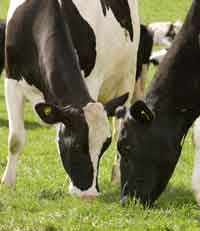Risk of cattle inbreeding in the UK is low

The emergence of seven bulls by one sire – O-Bee Manfred Justice – in the top 10 PLI bulls in last week’s Holstein bull proofs means inbreeding has the potential to become a problem in UK dairy herds, breeding experts say.
If O-Man’s sons continue to dominate bull proofs in two or three years, there may be a problem, says DairyCo breeding director Marco Winters. However, Mr Winters says unlike North America, where O-Man has been used extensively, he has never been used to the same level in the UK, meaning there are relatively few of his progeny in UK herds.
“O-Man’s semen has always been limited in the UK, which means there aren’t too many of his daughters about. Even his back sires, Elton and Manfred, have not been used widely, meaning the first cross of O-Man’s sons is not a concern.”
However, despite media reports highlighting inbreeding as a problem in UK dairy herds, Mr Winters believes the UK is in a good position. “Because we started off from a Friesian base in the UK and didn’t start introducing Holsteins until relatively recently, the UK’s inbreeding levels are 20-30 years behind North America, where herds are reaching inbreeding levels of 6.25%, which is at the top of what is deemed acceptable.”
The UK is below this level, at 3.5% for young milking heifers. And with numerous breeding tools coming on to the market, this will, hopefully, help stop inbreeding problems occurring, says The Dairy Group’s Bas Van Santen.
“There are many mating programmes available to help avoid inbreeding and they should be used. But, most important, to avoid it happening in your herd, you need good records. Having records of bulls used and clear identification of animals is critical so you know you are not inseminating with closely related genetics.”
Mr Van Santen agrees with Mr Winters that if bulls from a different family line are not supplied, then having a lot of high-ranking bulls from the same sire could be a problem. But he believes it will not get to this. “As long as other semen companies offer other bulls that can compete on Profitable Lifetime Index (£PLI) and Type, then we shouldn’t have a problem. I’m sure this will be the case,” he says.
The fact that most of O-Man’s sons are out of different maternal grandsires limits the inbreeding potential, says Mr Winters. “The seven O-Man sons in the top 10 are out of five maternal grandsires. If they had come from more closely-bred cow families, this also would be a cause for concern, but it’s not.”
Mr Winters also envisages sons of other leading sires, such as Shottle and Goldwyn, will enter the bull proofs, which will further dispel the potential for inbreeding. “Inbreeding is being monitored in the industry and when there is cause for concern, we will flag it. But at the moment there isn’t any,” he says.
